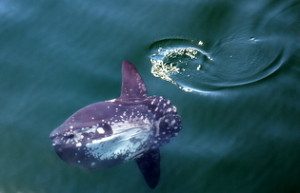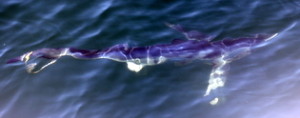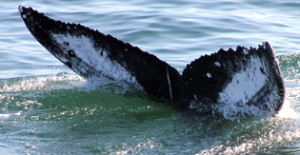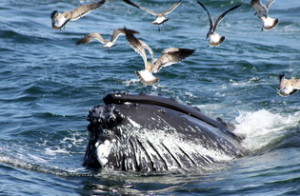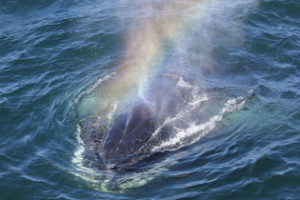August 27 to September 2
On August 27th we squeezed in a few morning trips before Hurricane Irene approached, and we started the day with a whale watch and ecology lesson just for kids! After a close boat approach from Scylla’s 2008 calf, the youngsters on the boat got a little hands-on ocean life experience with green crabs, common shore shrimp, scallops, mummichogs, and a very small sea bass!
The humpbacks were situated pretty far to the east, and it took some time to reach a group of three animals that were located off of Highland Light. Although the seas seemed glassy calm, we noticed a building swell from the southeast warning of the impending storm. The flat conditions allowed us to get a great look at a harbor seal bobbing in the swells. Like whales, harbor seals are considered marine mammals, but they are categorized in the order pinnipedia, which means “fin foot”. Harbor seals are considerably smaller than the gray seals which are also seen frequently off our coasts, and there is some evidence that these larger gray seals may be pushing the harbor seals out of prime haul out habitat on the shores!
Individual humpbacks seen: Pumpkinseed, Scylla’s 2008 Calf
After Hurricane Irene kept us on shore for two days, we were excited to get back on the water on August 30th. The storm seemed to have churned up the foods, and after a mellow few days, the humpbacks were back to a feeding frenzy off of Peaked Hill. In a single bubble cloud, six humpbacks emerged with their mouths full of food, swallowing thousands of sand lance with every mouthful. The birds swooping down to grab fish pushed to the surface including black terns, gulls, and four species of shearwaters!
Humpbacks don’t always travel in groups; rather, it is more likely that the presence of food is responsible for congregating groups of humpbacks in a single area. Once they are there, they sometimes will work together to blow huge nets of bubbles in which fish are entrapped. They don’t always feed in groups, however. We frequently see humpbacks feeding on their own. Their long pectoral flippers allow them to make agile movements to corral their prey even when there are no other whales around.
By the afternoon, the feeding had stopped, but there was still plenty of action. Circuit, a female first seen in 1999, was rolling on her side, slapping her flipper on the surface of the water. Notice the ridges along the flippers’ trailing edge which help the whale in making precise, hydrodynamic movements when navigating their ocean environment.
Individual humpbacks seen: Salt, Putter, Draco, Aswan, Level, Perseid, Division and calf, Midnight, Circuit, Rattan, Firefly, Pogo, Joy, Music, Entropy, Hippocampus, Pumpkinseed, Echo
The flat calm seas continued into August 31st and these incredible sighting conditions allowed us to spot many unusual species that we don’t often see on our excursions. The first occurred during our first trip of the day when we spotted a pointed dorsal fin sticking out of the water. The listing angle of the fin let us know right away that we had a Mola mola on our hands! Mola molas are ocean sunfish, and are known to move up and down in the water column in search of jellyfish, salp, and ctenophores. At their largest, these bizarre creatures can weigh several hundred pounds!
Later in the morning, a larger, wider dorsal fin emerging from the seas led us to a basking shark. These plankton-eaters have modified gill-rakers which trap copepods and other invertebrates that stream into the sharks mouth as they swim forward, mouth agape.
Then, for the first time this summer, a second species of shark was seen on the same day! In the early afternoon, we saw not one, but four blue sharks! Much smaller and sleeker in appearance than the basking shark, the blue shark can reach lengths of 12 feet, and is distinguished by its long pectoral flippers.
Finally, our day of unusual sightings was topped off by a look at a mid-sized pod of Atlantic white-sided dolphins. These small cetaceans travel in and out of the Stellwagen Bank throughout the year. Today, between 90 and 120 of them leaped and surfed our bow as we got great looks at the distinctive tan and white markings on their sides.
Individual humpbacks seen: Ganesh and calf, Putter, Perseid, Salt, Midnight, Echo, Entropy, Liner’s 2008 calf, Pumpkinseed, Circuit, Reflection, Buzzard, Hippocampus
This pod of dolphins seemed to have split overnight as a smaller group of just 15-20 dolphins was seen just north of Race Point on September 1st. As we approached the area, we weren’t sure if we were looking at bluefin tuna or dolphins, as their body size and shape is rather similar; however, as we got closer, the tan and white streaks on the side of the dolphins body revealed their identity. These dolphins were moving fast. Rather than engaging with the wake of the boat as they often do, they were booking it solidly northward, possibly to re-join the rest of their con-specifics.
We located a group of humpbacks extremely close to shore near Highland Light. At one point during the trip, we were surprised to find ourselves in less than 50 feet of water watching Backgammon, a humpback first seen in 2008, arch and fluke.
As if to honor the first day of September, our first common loon of the autumn made an appearance, both vocally and visually. These distinctive birds have a loud, hooting call that is hard to mistake for anything else!
Individual humpbacks seen: Salt, Putter, Entropy, Rattan, Pogo, Backgammon, Echo, Tear, Midnight, Entropy, Buzzard, Joy
On September 2nd, we headed straight back to Highland Light. This landmark, on a dramatic bluff in Truro, is over an hours’ ride from Provincetown, but we knew that our humpbacks had been hanging out there on a pretty reliable basis for the past few days. Sure enough, upon our arrival we found Midnight and Pogo. Midnight is easily recognizable by her nearly all-black fluke and noticeably tiny dorsal fin.
Pogo and and Midnight started feeding with bubble nets and were soon joined by I-Vee’s 2008 calf. They fed together for a few lunges before I-Vee’s 2008 calf went off with two unknowns.
We also came upon Echo, a known calving female. We have been noticing that Echo’s skin has been looking rather gray over the past few weeks. Humpbacks normally have shiny black skin, and gray skin could be a sign of infection or other ill-health. We will continue to keep our eye on Echo for other changes to her skin or body. Despite her less-than-healthy appearance, Echo was energetic in the afternoon, spending almost a half an hour breaching and flippering. She flippered so vigorously that the edges of her flippers were pink and raw!
After spending the first part of our trip near Peaked Hill and Highland Light, we received a call that there were humpbacks in the Bay. We spend much of the spring watching humpbacks, fin whales, Minkes and right whales within the confines of Cape Cod Bay, but for the most part, they stay to the north after summer rolls around, so it was unusual to see them so close in. We suspected maybe they were lured there by a new source of food, as we noticed that they were performing regular, slow side lunges. Humpbacks feed differently depending on what sort of prey they are after. Side lunges are frequently indicative of a krill patch. While we could not see much prey in the water, we were intrigued by the difference in feeding style, especially as it compared to what we had seen earlier that morning.
A few of these feeding bouts occurred right under the bow of the Dolphin VII. We were able to identify Banyon, Komodo, Jabiru, and Hippocampus in the group.
As we turned and passed the four, two more whales breached behind us, but only a lucky few got to see them as it happened only once. Luckily, we got another treat on the way home. We stopped just south of Race Point at a very small basking shark. These huge fish can reach lengths of over 30 feet, but this little guy barely topped 10! This shark was making its appearance known and slashing at the surface, giving everyone a great look at what will eventually be one of the largest fish on the planet!
Individual humpbacks seen: Midnight, Pogo, Komodo, Jabiru, Banyon, Echo, Pivot, I-Vee’s 2008 calf, Hippocampus, Gladiator, Elephant, Tear, Pumpkinseed, Algebra, Scylla’s 2008 calf










